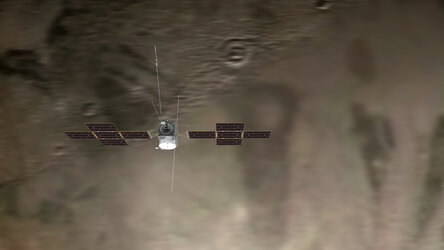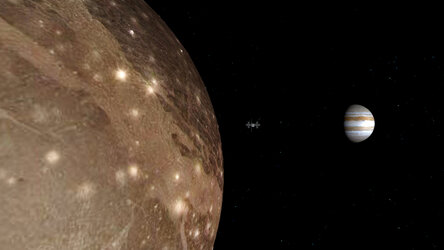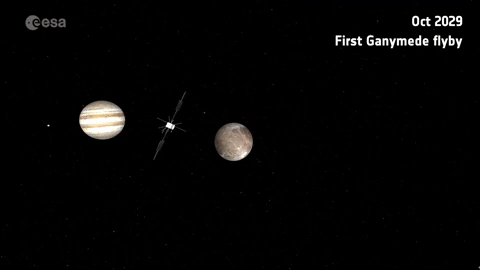
Juice orbits around Ganymede (artist’s impression)
When Galileo first spotted Ganymede in 1610, he could hardly have imagined that we would one day be sending a spacecraft to get up close and personal with the giant moon.
Monstrous, mysterious Ganymede is the primary target of ESA’s Jupiter Icy Moons Explorer (Juice) and the largest moon in the Solar System – larger even than Pluto and Mercury! Though Juice will make flybys of all three of Jupiter’s largest Galilean moons (Ganymede, Europa and Callisto), Ganymede is the only one that the spacecraft will orbit. In doing so, Juice will become the first spacecraft ever to orbit a moon other than our own, enabling us to see the Jovian world in a whole new light.
Ganymede is also the only moon in the Solar System to generate its own magnetic field. Juice will explore various key topics: Ganymede’s puzzling magnetic field, its hidden ocean, its complex core, its ice content and shell, its interactions with its local environment and that of Jupiter, its past and present activity, and whether or not the moon could be – or ever have been – a habitable environment.
Ganymede is an especially exciting target for a number of reasons. It displays a wide range of surface ages and features, offering a geological record spanning several billion years; it has an active magnetic dynamo and subsurface ocean; and has a complex and unique relationship with the space environment around its parent planet, Jupiter. Notably, Ganymede’s intrinsic magnetic field has generated a mini ‘magnetic bubble’ (magnetosphere) sitting within Jupiter’s larger one, and the two interact in highly complex and intriguing ways.
Juice will shed light on these aspects by…
- …determining the extent, composition and dynamics of Ganymede’s subsurface ocean, including how water transfers from the deep interior to upper ice shell, and seeking signs of shallow subsurface water reservoirs;
- …characterising Ganymede’s magnetic field, revealing what drives and maintains the moon’s internal dynamo, and identifying the particle groups found around the moon (how are these replenished, and how do they interact with Ganymede and Jupiter?);
- …exploring how Ganymede’s surface features, processes and topography relate to its subsurface, defining the thickness and structure of the moon’s icy crust and mapping its geology, composition, chemistry and evolution over time.
Juice will end its mission by colliding with Ganymede’s surface in 2035.
Discover more about Juice and Jupiter’s icy moons.
ESA’s Jupiter Icy Moons Explorer, Juice, is humanity’s next bold mission to the outer Solar System. It will make detailed observations of gas giant Jupiter and its three large ocean-bearing moons – Ganymede, Callisto and Europa. This ambitious mission will characterise these moons with a powerful suite of remote sensing, geophysical and in situ instruments to discover more about these compelling destinations as potential habitats for past or present life. Juice will monitor Jupiter’s complex magnetic, radiation and plasma environment in depth and its interplay with the moons, studying the Jupiter system as an archetype for gas giant systems across the Universe.
Juice launches on an Ariane 5 from Europe’s Spaceport in Kourou in April 2023. It has an eight year cruise with flybys of Earth and Venus to slingshot it to Jupiter. It will make 35 flybys of the three large moons while orbiting Jupiter, before changing orbits to Ganymede.
Juice is a mission under ESA leadership with contributions from NASA, JAXA and the Israeli Space Agency. It is the first Large-class mission in ESA’s Cosmic Vision programme.






